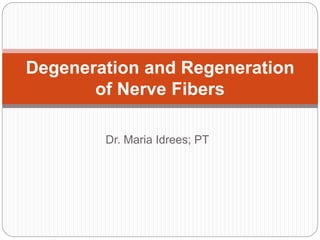
Degeneration and regeneration of nerve fibers
- 1. Dr. Maria Idrees; PT Degeneration and Regeneration of Nerve Fibers
- 2. INTRODUCTION When a nerve fiber is injured, various changes occur in the nerve fiber and nerve cell body. All these changes are together called the degenerative changes.
- 4. Causes for Injury Injury to nerve fiber occurs due to following causes: 1. Obstruction of blood flow 2. Local injection of toxic substances 3. Crushing of nerve fiber 4. Transection of nerve fiber.
- 5. DEGREES OF INJURY Sunderland had classified the injury to nerve fibers into five categories depending upon the order of severity. „FIRST DEGREE First degree injury is the most common type of injury to the nerves. It is caused by applying pressure over a nerve for a short period leading to occlusion of blood flow and hypoxia.
- 6. By first degree of injury, axon is not destroyed but mild demyelination occurs. It is not a true degeneration. Axon looses the function temporarily for a short time, which is called conduction block. The function returns within few hours to few weeks. First degree of injury is called Seddon neuropraxia.
- 7. SECOND DEGREE Second degree is due to the prolonged severe pressure, which causes Wallerian degeneration. However, the endoneurium is intact. Repair and restoration of function take about 18 months. Second degree of injury is called axonotmesis.
- 8. THIRD DEGREE In this case, the endoneurium is interrupted. Epineurium and perineurium are intact. After degeneration, the recovery is slow and poor or incomplete. Third, fourth and fifth degrees of injury are called neurotmesis.
- 9. FOURTH DEGREE This type of injury is more severe. Epineurium and perineurium are also interrupted. Fasciculi of nerve fibers are disturbed and disorganized. Regeneration is poor or incomplete. „FIFTH DEGREE Fifth degree of injury involves complete transaction of the nerve trunk with loss of continuity. Useful regeneration is not possible unless the cut ends are rearranged and approximated quickly by surgery.
- 10. DEGENERATIVE CHANGES IN THE NEURON Degeneration refers to deterioration or impairment or pathological changes of an injured tissue. Accordingly, degenerative changes are classified into three types: 1. Wallerian degeneration 2. Retrograde degeneration 3. Transneuronal degeneration.
- 12. WALLERIAN DEGENERATION OR ORTHOGRADE DEGENERATION Wallerian degeneration is the pathological change that occurs in the distal cut end of nerve fiber (axon). It is named after the discoverer Waller. It is also called orthograde degeneration. Wallerian degeneration starts within 24 hours of injury. Change occurs throughout the length of distal part of nerve fiber simultaneously.
- 13. Changes in Nerve i. Axis cylinder swells and breaks up into small pieces. After few days, the broken pieces appear as debris in the space occupied by axis cylinder. ii. Myelin sheath is slowly disintegrated into fat droplets. The changes in myelin sheath occur from 8th to 35th day. iii. Neurilemmal sheath is unaffected, but the Schwann cells multiply rapidly. Macrophages invade from outside and remove the debris of axis cylinder and fat droplets of disintegrated myelin sheath. So, the neurilemmal tube becomes empty. Later it is filled by the cytoplasm of Schwann cell. All these changes take place for about 2 months from the day of injury.
- 16. RETROGRADE DEGENERATION Retrograde degeneration is the pathological changes, which occur in the nerve cell body and axon proximal to the cut end. Changes in Nerve Cell Body Changes in the nerve cell body commence within 48 hours after the section of nerve. The changes are: i. First, the Nissl granules disintegrate into fragments by chromatolysis ii. Golgi apparatus is disintegrated
- 17. iii. Nerve cell body swells due to accumulation of fluid and becomes round iv. Neurofibrils disappear followed by displacement of the nucleus towards the periphery v. Sometimes, the nucleus is extruded out of the cell. In this case, death of the neuron occurs and regeneration of the injured nerve is not possible. Changes in Axon Proximal to Cut End In the axon, changes occur only up to first node of Ranvier from the site of injury. Degenerative changes that occur in proximal cut end of axon are similar to those changes occurring in distal cut end of the nerve fiber.